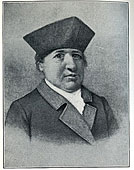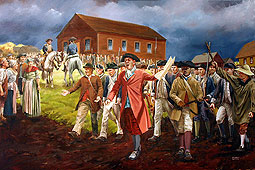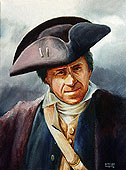For Teachers: Lessons
Lesson 4: Petition & Protest: “our property is torn from us”
Learning Objectives
After completing this lesson, students will be able to:
- Explain why the Regulators tried to close courts in Massachusetts in the 1780’s
- Compare and contrast the concerns of the Regulators, the Massachusetts government, and ordinary citizens in the wake of court closings
- List the strategies used by the Regulators to get their grievances heard and responded to, and discuss why each method was or was not successful
- Discuss the rationale of the Massachusetts government in declaring the actions of the Regulators to be unconstitutional
- Describe how the government planned to protect the courts
- Describe ordinary citizen’s thoughts and feelings about the events in Springfield, as gleaned from diaries and journals
- Examine and analyze primary source materials
- Analyze maps
Skills
- Interpreting visual information
- Observing and describing
- Thinking critically
- Expressing opinions
- Analyzing visually
- Understanding historical perspective
- Gathering and using information
- Interpreting information
Introduction
In this lesson, students learn that petitioners and protesters considered the post-war crisis to be constitutional as well as fiscal, and used forced court closings, county convention resolves, and petitions to force the state Legislature to address their grievances. The Legislature and its supporters agreed that economic problems stimulated the protests, but they refused to accept the argument that complaints about fiscal policies, court fees, and property dispossessions were ultimately constitutional issues. The scene is set outside the courthouse in Springfield, MA, in September of 1786. The Supreme Judicial Court is meeting inside, while several hundred Regulators are marching in front of the courthouse, and a smaller group of better-armed militia is stationed at the courthouse.
 |
 |
 |
| Major General William Shepard, Courtesy Pocumtuck Valley Memorial Association, Deerfield, Ma | Petition & Protest, ©2008 Bryant White | Captain Daniel Shays, © 2008 Bryant White |
Guiding Concepts
The Springfield Court was only one of several courts closed during the fall and winter of 1786. Closing courts had practical as well as symbolic effects; their closure both prevented the court from indicting men who had participated in the closing of lower courts, and sent a strong message that the courts’ actions betrayed the principals of free government. Court closings were only one of several strategies Massachusetts citizens used to get the attention of the state Legislature.Other strategies included petitions for debtor relief legislation; requests for paper currency to alleviate economic hardships made worse by the scarcity of cash; county convention resolves; town petitions to the Legislature; and newspaper articles criticizing the Legislature, its policies, and the Massachusetts Constitution of 1780. While court closings and county conventions were not a new form of protest, in the wake of republican revolution and the new state constitution of 1780, this form of protest had lost its legitimacy in the eyes of many state leaders.
Preparing to Teach
- Familiarize yourself with the Petition and Protest historic scene, linked to from the Historic Scene menu. Read the three tabs, then roll your cursor over the highlighted hot spots in the illustration. Follow the links in the rollovers. Below the illustration and the tab content, read the four OBSERVER comments, the four essays in the THEMES section, and follow the links in the RELATED TO THIS SCENE section.
- Familiarize yourself with the Library of Congress’ Using Primary Resources.
- Although not explicitly referred to in the lesson, you can incorporate selections from the Timeline and Music section into the lesson. For example, the song "Address to the Ladies" in the Polite and Tavern Music section, helps illustrate the economic downturn.
Teaching the Lesson
- Class Assignment: Prior to the one or two class periods spent on this lesson, make the following website preparation assignment:
- From the Historic Scene menu, go to the Petition and Protest historic scene. Read the Overview tab, the Government tab, and the Regulators tab. Roll your cursor over the rollovers within the illustration and read the text. Note that only the highlighted rollovers for each tab display pop-ups. There are very few rollovers for the government tab since the scene depicts mostly the army.
- Read the observer comments, the four essays in the themes section, and follow the links in the related to this scene section, studying the material displayed.
- Go to the Map menu and select "The Events of Shays Rebellion—An Animated Sequence" map. Click the first few slides in the sequence to see the court closings.
- Assign each of the following characters to students (or a small group of students) so the student(s) can assume that historic persona in class: General William Shepard, Captain Daniel Shays, Captain Agrippa Wells, Jason Parmenter, Moses Sash, and Justin Hitchcock. All of these narratives are found in the People menu. Students should read and study the narrative of their assigned persona. Also assign one student to be the historian George Minot, and read selections from his book The History of the Insurrections.
- Assign the following observers to students (or a small group of students) so the student(s) can assume that historic persona in class: Jonathan Judd, Nahum Jones, Henry Lee, Henry Knox. Note that Jonathan Judd and Henry Knox have character narratives in the People menu.
- Diary or journal entries can be used to assign to additional personas. For example, you can use the links in the related to this scene section below the illustration to assign the excerpts from the journal of Captain Park Holland, and the journal of Sarah Howe. Ask students to think about the evidence of economic hardship they find in these diaries and journals. Note that other journals and diary entries can be found by searching manuscripts with a keyword of “diary” or “journal” in the Artifacts & Documents section of the website. For example, additional first-person accounts and excerpts can be found for Sylverster Judd, Justice Forward, Elihu Ashley, and Justin Hitchcock. A biographical selection for Joseph Stebbins also exists. Daniel Gray's Address to the People about Regulator grievance is also worth looking at.
- Assign the persona of General Bowdoin to a student, who should read his Proclamation of November 7, 1786, also found in the related to this scene links.
- Assign a student excerpts from Our Busy Town by Kelsey Flower, where he recounts Justin Hitchcock’s description of the experience of the militia at the court closings.
- Class Activity: Debate: Are Regulator Protest Methods Constitutional? Assemble the historic personas at the front of the class. Make sure the government side is familiar with the Government tab, and the Regulator side is familiar with the Regulator tab. George Minot, the historian, General William Shepard, Governor Bowdoin, and Hitchcock will argue on behalf of the government, while Shays, Wells, Parmenter and Sash will argue on behalf of the Regulators. Wells will emphasize his “change of heart” when he marched on Springfield. Stage a debate between both sides about the constitutionality of protest methods, especially those of closing the courts. Ask whether there were just two sides, or if there were people caught in the middle, perhaps sympathizing with the concerns of the Regulators, but not wanting there to be violence. Ask if students see any parallels between these protest methods and protests of the twentieth century. Use the discussion questions below.
- Class Activity: Primary Resource Study: Project the image of General Shepard’s letter to Governor Bowdoin. Use the zoom function to look carefully at the letter in the original handwriting, then look at the transcription. Discuss the meaning of the letter in the larger context of this scene. Do the same with General Washington’s letter to General Lincoln, followed by General Lincoln’s return letter to Washington. Compare and contrast sentiments in the letters.
- Class Activity: Diary Writing: Ask each student to write his/her own diary entry (after reading the diary/journal/autobiographical entries mentioned above) to record their thoughts and feelings about the events that took place at the courthouse in September of 1786. Their entries should reflect both what they observed, as well as their opinions about the Regulators, the government, the government militia, and the court judges. They should be prepared to read these diary entries in class.
- Class Discussion Questions:
- Why did men from Massachusetts towns throughout the Connecticut River Valley march to Springfield to close the Supreme Judicial Court scheduled to convene on September 26, 1786? (they had a list of grievances among which were the following: crushing debt (both private and due to high taxes), loss of their lands to pay veteran’s certificates that had been bought up by speculators, perception that judges and lawyers were getting rich off them, sense that they were being ignored by the Legislature, etc.)
- Why did men who originally set out to support the government change sides? Give an example. (Agrippa Wells)
- What evidence is there in journals and diaries that economic problems exist?
- How were the Regulators armed compared to the government militia? (poorly) What was the significance of the evergreen sprigs in their hats? (resistance to tyranny)
- What was the list of demands, presented by Daniel Shays’ to General Shepard? (court should not indict Regulators who had marched to close lower courts, or meet again until the people’s grievances had been redressed; courts should dismiss the government militia)
- What happened? (General Shepard refused to meet the demands; judges convened but adjourned without hearing any cases)
- How do you think the bystanders felt about what was happening?
- Why did Shepard allow the Regulators to march unmolested?
- What was the Legislature’s attitude toward the Regulators? (ignored much that they did, but condemned the court closings as unconstitutional and unnecessary)
- Why was the attempt to close down the Supreme Judicial Court so alarming to the government? (previous court closings were aimed only at the Courts of Common Pleas, lower courts)
- Why were the events a Springfield in September of 1786 significant for General Shepard, Daniel Shays and Moses Sash? (event marked first major appearance on the scene of General Shepard who armed the militia for the first time from the Springfield Arsenal; Daniel Shays became the leader of the Regulators; and an African-American man from Worthington, named Moses Sash — was one of the few African Americans we know about who took part in Shays’ Rebellion.)
Additional Resources
Books
- Gross, Robert, ed. In Debt to Shays: The Bicentennial of an Agrarian Rebellion, volume 65. Boston, MA: The Colonial Society of Massachusetts, 1993.
- Richards, Leonard. Shays’s Rebellion: The American Revolution’s Final Battle. Philadelphia: University of Pennsylvania Press, 2002.
- Starkey, Marion. A Little Rebellion. New York: Knopf, 1955.
- Satzmary, David. Shays’ Rebellion: The Making of an Agrarian Insurrection. Amherst, MA: University of Massachusetts Press, 1980.
Websites
- Library of Congress: Using Primary Resources
- Library of Congress: Digital Resources Related to the American Revolution
- Library of Congress: American Memory
- Shay’s Rebellion Song
- Best of History Websites: American Revolution and Independence
- PBS: Liberty: The American Revolution
- Edsitement: History and Social Studies
- James Madison Center: US History Curricula
- History Institute, University of Massachusetts: Shays’ Rebellion and Related Resources
Movies
- The History Channel Series: 10 Days That Changed America: Shays’ Rebellion: America’s First Civil War; 60 minutes
- Calliope: A little Rebellion Now and Then: Prologue to the Constitution; 30 minutes